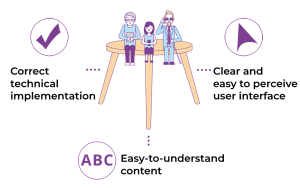Accessibility overview
Accessibility of the online world
Today, the Finnish word esteettömyys (accessibility) is used especially when we talk about the ease and functionality of buildings and other built environments. This accessibility means that it is easy to go to an agency, a cinema or a library, for example, even if you move around in a wheelchair or with a pram or you cannot see properly.
An environment or an individual building is accessible when it is functional, safe and comfortable for different users and when all the building’s premises are easy to access.
The Finnish word saavutettavuus (accessibility) is fairly well established when talking about digital services, i.e. websites and mobile applications. This accessibility thus means accessibility to the digital world: that it is easy for different people to use digital services and their contents. Accessibility improves equality in the digital society.
When accessibility has been taken into account as well as is possible, various people can use digital services independently. It increases the independence and inclusion in society of persons with disabilities.
Accessibility means technology, ease of use and comprehensibility of content

Three areas must be taken into account in the design and implementation of an accessible digital service:
- technical implementation
- ease of use and
- clarity and comprehensibility of content.
Technical accessibility
The source code of a digital service that is well implemented technically is accurate and logical. The HTML standard and WCAG guidelines have been followed and the service functions well on various terminal devices and assistive technologies, such as voice control and screen readers.
Ease of use
Ease of use means that the digital service is easy to understand, the navigation is clear and that each page, function or content is easy to find. Navigation should not be too multi-level and page names should be descriptive and clear. The main content is clearly distinguishable from other elements of the page. It is easy to perform the desired function in the service.
Comprehensibility
The comprehensibility of content is important for all users and a key part of an accessible digital service. This means the use of clear, understandable language and also plain language. The text should be easy to read and structured into short paragraphs and lists. An adequate amount of descriptive subheadings should be used. Link texts should also be descriptive and easy to understand.
Comprehensibility also includes the idea of a multi-channel approach: content is also offered as videos, images and sound in addition to text.
Accessibility is a customer-oriented approach
Accessibility can also be considered as a perspective that draws attention to different users, their various situations, needs and possible limitations or challenges. Accessibility is also a key aspect of a customer-oriented approach.
Because people are all very different, there are also different needs regarding accessibility. What is accessible to one person is not adequate for another.
For example, a person with a hearing impairment will not have access to information from a video containing speech that has not been subtitled. On the other hand, a person with a visual impairment will have access to the information in the same video if the video’s soundtrack is comprehensive, and they will only lack access to the information presented in visual format.
It is essential that the situations and needs of different users are understood and taken into account as well as is possible when designing and implementing websites and mobile applications and their contents.
Design for All principle
Accessibility is a key aspect of the to the Design for All principle. The purpose of the Design for All principle is to take into account different users right from the beginning of the design process and to implement a single service that can be used by all different people.

